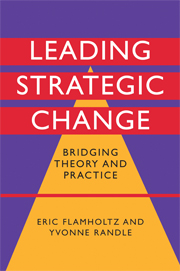Book contents
- Frontmatter
- Contents
- List of exhibits
- Preface
- Acknowledgments
- Part I An integrative framework for leading strategic and organizational change
- Part II Leading strategic change in actual organizations
- 4 Leading strategic and organizational change at Countrywide Financial Corporation
- 5 Leading change at Starbucks Coffee Company
- 6 Strategic marketing through HR interventions: a case study of Indian Oil Corporation
- 7 The evolution of Stan Tashman and Associates
- 8 Leading strategic and organizational change at IndyMac Bank
- 9 Leading strategic and organizational change at Infogix
- 10 Leading strategic and organizational change: the transformation of structure at Pardee Homes
- 11 Leading strategic and organizational change at Tata Steel: the role of culture
- 12 Leading strategic and organizational change at Westfield: transformation to a global enterprise
- Part III Leading strategic change: lessons learned from practice
- Appendix: References for further reading on leading change
- Index
4 - Leading strategic and organizational change at Countrywide Financial Corporation
from Part II - Leading strategic change in actual organizations
Published online by Cambridge University Press: 22 September 2009
- Frontmatter
- Contents
- List of exhibits
- Preface
- Acknowledgments
- Part I An integrative framework for leading strategic and organizational change
- Part II Leading strategic change in actual organizations
- 4 Leading strategic and organizational change at Countrywide Financial Corporation
- 5 Leading change at Starbucks Coffee Company
- 6 Strategic marketing through HR interventions: a case study of Indian Oil Corporation
- 7 The evolution of Stan Tashman and Associates
- 8 Leading strategic and organizational change at IndyMac Bank
- 9 Leading strategic and organizational change at Infogix
- 10 Leading strategic and organizational change: the transformation of structure at Pardee Homes
- 11 Leading strategic and organizational change at Tata Steel: the role of culture
- 12 Leading strategic and organizational change at Westfield: transformation to a global enterprise
- Part III Leading strategic change: lessons learned from practice
- Appendix: References for further reading on leading change
- Index
Summary
Introduction
Recognizing the mounting threats to its leadership position, in late October 1999 Countrywide Financial Corporation invited Eric Flamholtz, Professor of Management at UCLA's Anderson School of Management and President of Management Systems Consulting Corporation, his own consulting firm, to its annual planning meeting. He was asked to present a strategic planning framework for building the organizational capability needed to sustain long-term success and to adapt to environmental changes. He was also asked to facilitate a preliminary planning session in which Countrywide's senior managers would be introduced to the concept of approaching planning in relation to longer-term business issues.
While Stanford Kurland, Countrywide's COO, was accustomed to considering longer-range issues for the company, most of the other members of Countrywide's senior management team were more focused on achieving competitive success in the current, as opposed to the future, market. The team also believed that they were very good at strategy, and the company's financial performance up until that point had validated their assertions.
Nevertheless, the session with Flamholtz triggered the realization that, though the company was performing well, it was necessary for management to extend its thinking beyond incremental performance improvement goals and to begin to address longer-term, environmental issues, as well as changing competitive dynamics.
This chapter gives an account of the process undertaken to respond to these changing industry dynamics. It also describes how the company made the subtle, yet profound, transformation from a small entrepreneurial venture to an entrepreneurially oriented, professionally managed organization.
- Type
- Chapter
- Information
- Leading Strategic ChangeBridging Theory and Practice, pp. 69 - 85Publisher: Cambridge University PressPrint publication year: 2008



